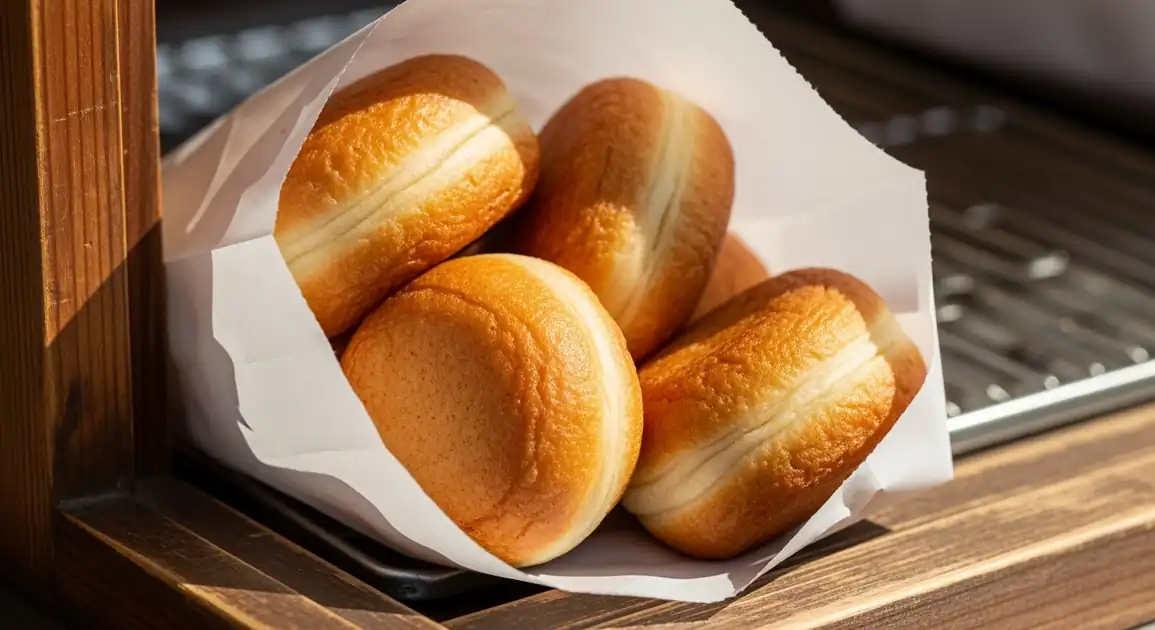Agemanju (Deep-fried Manju)
揚げまんじゅう

Description
Agemanju is a popular fried sweet snack found across Japan, particularly common in tourist destinations, temple towns (like Nara, Kamakura), traditional shopping arcades ('shotengai'), and department store food halls ('depachika'). While fillings vary, the core concept of a deep-fried sweet bun remains consistent.
Dietary Information
Serving information
Serving style
Served hot, typically handed over in a small paper bag or on a paper tray/napkin. Intended for immediate consumption.
Quick facts
Shops typically open around 10 AM and close between 5 PM and 7 PM. Depachika stalls follow department store hours (e.g., 10 AM - 8 PM).
Safety Tips
What to Look For
-
Vendor actively frying or keeping Agemanju visibly hot.
Ensures the Agemanju is fresh, crispy, and served at a safe temperature, minimizing risk and maximizing taste.
-
Clean oil (relatively light color, no excessive smoke or debris).
Hot, clean oil cooks efficiently, reduces greasiness, and prevents off-flavors or harmful compounds from burnt oil.
-
Clean shop front, utensils, and handling practices.
General cleanliness indicates better hygiene standards, reducing the risk of contamination.
-
High customer turnover.
A busy shop usually means the Agemanju are freshly made and haven't been sitting around for long.
What to avoid
-
Agemanju that looks cold, stale, or has been sitting out for a long time.
Best enjoyed fresh for texture and safety. Cold fried food can be unappetizing and potentially harbor bacteria if left at room temperature too long.
-
Excessively dark, dirty-looking, or smoking frying oil.
Indicates old or overheated oil, which negatively impacts flavor and can contain undesirable compounds.
-
Vendors with poor hygiene (e.g., handling money then food without gloves/washing hands).
Increases the risk of bacterial contamination.
-
Agemanju that looks overly greasy or soggy.
Suggests improper frying temperature or technique, affecting quality and enjoyment.
Price information
Price range
Budget tips
- Prices are usually per piece.
- Expect to pay around 120-250 JPY for standard Agemanju from street stalls or specialty shops.
- Prices might be slightly higher in department stores ('depachika') or very famous shops.
- Look for multi-buy deals if purchasing several pieces, although this is less common.
Value indicators
- Fried fresh to order or kept noticeably hot.
- Crispy, non-greasy exterior.
- Generous amount of filling.
- Good balance between bun and filling sweetness.
Where to Find This Dish
Temple Approach Roads ('Sando')
Streets leading to major temples/shrines often have traditional snack shops selling Agemanju.
Senso-ji (Tokyo), Kiyomizu-dera (Kyoto), Todai-ji (Nara) approach
Daytime (temple visiting hours)
Tourist Hotspots / Shopping Streets
Busy areas popular with tourists often feature Agemanju stalls or shops.
Nakamise-dori (Tokyo), Nishiki Market area (Kyoto), Takeshita Street (Tokyo - less common but possible)
Daytime, Early Evening
Department Store Basements ('Depachika')
Upscale food halls in department stores often have stalls selling high-quality or branded Agemanju.
Major department stores like Mitsukoshi, Takashimaya, Isetan
Store operating hours (approx. 10 AM - 8 PM)
Vendor Tips
- Look for established shops with a history ('shinise') for potentially higher quality.
- Observe if they are frying continuously; indicates freshness.
- Check signs for different fillings ('koshian', 'tsubuan', 'matcha', 'goma', etc.).
How to Order
Regional Variations
-
Koshian Agemanju
(こし餡揚げまんじゅう)
Filled with smooth, strained sweet red bean paste. The most classic type.
-
Tsubuan Agemanju
(粒餡揚げまんじゅう)
Filled with chunky sweet red bean paste, retaining some bean texture.
-
Matcha Agemanju
(抹茶揚げまんじゅう)
Filling is sweet bean paste flavored with matcha green tea powder.
-
Goma Agemanju
(ごま揚げまんじゅう)
Often filled with sweet black sesame paste ('kuro goma an'). Some variations might have sesame seeds mixed into the dough or sprinkled on top.
-
Imo Agemanju / Sweet Potato Agemanju
(芋揚げまんじゅう)
Filled with sweet potato paste ('imo an').
-
Kuri Agemanju / Chestnut Agemanju
(栗揚げまんじゅう)
Filled with sweet chestnut paste ('kuri an'), sometimes with chestnut pieces. Popular in autumn.
-
Tempura Manju
(天ぷらまんじゅう)
A similar concept where the manju is coated in tempura batter before being deep-fried, resulting in an even lighter, crispier coating. Sometimes considered a distinct snack.
Cultural context
History
Manju itself has origins tracing back to China, introduced to Japan centuries ago and adapted into countless variations ('wagashi'). The practice of deep-frying Manju (Agemanju) likely emerged as a popular street food innovation, possibly influenced by tempura techniques, adding textural excitement and warmth, especially appealing to visitors exploring temple grounds or bustling shopping streets like Asakusa's Nakamise-dori in Tokyo, where specific shops have become famous for it.
Local significance
Agemanju is a beloved casual snack ('oyatsu') and a popular type of 'wagashi' (traditional Japanese confection). It represents a modern twist on a traditional sweet, often associated with temple visits or exploring historic areas.
Eating customs
- Best eaten immediately while hot and crispy.
- Consumed by hand, using the provided wrapper/napkin.
- Avoid eating inside temples or shrines unless in designated rest areas.